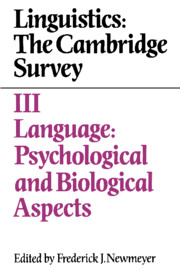Book contents
- Frontmatter
- Contents
- Contributors
- Preface
- 1 Psycholinguistics: an overview
- 2 Language and cognition
- 3 Processes in language production
- 4 Language perception
- 5 The mental lexicon
- 6 Where learning begins: initial representations for language learning
- 7 Second language acquisition
- 8 Neurolinguistics: an overview of language–brain relations in aphasia
- 9 The biological basis for language
- 10 Linguistics and speech–language pathology
- 11 The evolution of human communicative behavior
- 12 Linguistics and animal communication
- Index of names
- Index of subjects
- Contents of Volumes I, II, and IV
7 - Second language acquisition
Published online by Cambridge University Press: 03 February 2010
- Frontmatter
- Contents
- Contributors
- Preface
- 1 Psycholinguistics: an overview
- 2 Language and cognition
- 3 Processes in language production
- 4 Language perception
- 5 The mental lexicon
- 6 Where learning begins: initial representations for language learning
- 7 Second language acquisition
- 8 Neurolinguistics: an overview of language–brain relations in aphasia
- 9 The biological basis for language
- 10 Linguistics and speech–language pathology
- 11 The evolution of human communicative behavior
- 12 Linguistics and animal communication
- Index of names
- Index of subjects
- Contents of Volumes I, II, and IV
Summary
Introduction
Research on second language acquisition is an especially complicated endeavor. The working out of a complete grammar of a single language is a task of enormous complexity, one that has yet to be completed for any human language. It is all the more daunting, then, to realize that an understanding of all the factors influencing a language learner's performance demands a fairly well-articulated analysis of at least two languages, the native language and the target language. Furthermore, while linguists attempting to describe the grammatical patterns of a single language must deal with the complicating factors of social and regional variation, anyone investigating the acquisition of a foreign language must grapple not only with these but with a host of additional relevant variables: the age at which the learner was exposed to the foreign language; the type of exposure to the foreign language (through formal instruction or outside the classroom); the learner's knowledge of other foreign languages. And while linguists can fairly safely assume that all adult native speakers of a language have reached a particular stage of mastery of the core grammar of that language, learners of a foreign language may have widely varying levels of competence and motivation.
Yet the potential rewards of such study are considerable. The systematic errors of second language learners can provide a valuable source of external evidence to test linguistic theories. For example, where particular error patterns are associated with particular native language backgrounds, we may assume that these errors provide some reflection of the grammatical system of the first language – the sort of evidence which may not be available from evidence internal to the first language.
- Type
- Chapter
- Information
- Linguistics: The Cambridge Survey , pp. 194 - 209Publisher: Cambridge University PressPrint publication year: 1988
- 3
- Cited by

